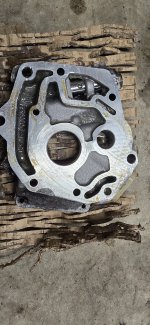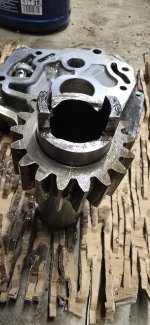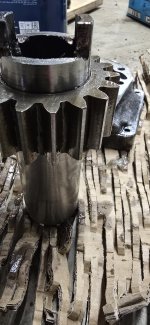Hello all,
Back at it in the final stages of buttoning up a full rebuild on a 1989 Tabert camper based on a 280 chassis.
I've fully rebuilt the 2.5td, the only thing I haven't replaced is the assembly that runs off the cam belt and runs the oil pump, power steering, fuel pump assembly and vacuum pump.
Pretty much started on the button first try once fuel got back in to the lines. Oil pressure light didn't go off after about 20 seconds of nervewracking idle. Shut it down. Tried again. No luck. Checked oil level, wiring etc. After several such attempts (I did use a lot of assembly lube) I started to get very uncomfortable at the idea of running the engine longer.
I pulled the oil pan and it's brand new gasket and checked all was good with the pickup tube. I then fashioned a hose to attach to the pickup tube at the screen to manually prime the system. As I was doing this with a helper we noted not only did it seem to work but oil started dripping out of all the gallery's across the crankshaft. This made me feel a little better. Re-assembled with a new pan gasket, stil no oil pressure!
After making sure it wasn't the switch and a few more tries I attached a manual gauge in place of the switch. It read less than 0.25 bar cranking. I didn't want to run it again.
Decided to dive into the oil pump as much as possible without removing the whole assembly and having to redo timing belt etc. Pulled the vacuum pump and the next "layer" about 1.5cm thick piece that directs oil and covers a gear. Seems from what I can find this is the oil pump. Packed it all with a ton of grease. put it back together. Fired it up, and after about 15 not so fun seconds, the oil pressure light finally went off! HOWEVER, the top end sounded very ticky to me and I hadn't put the cooling system back together yet so I didn't run it long. This was a few weeks ago.
I buttoned up the cooling system today and wanted to go for it's first drive. I figured the lifters just need a bit more oil or something of the sort.
Guess what: no oil pressure again. I've ran it 3 times for 20 seconds each hoping it would build pressure and it simply won't. Pulled the oil filler cap and heat escaped and the top end is dry as a bone. Not good.
I'm doing all of this as a favour for a friend. No good deed goes unpunished. At this point I need my lift back and wan't the thing done.
It was run dry, which is why it needed a new crank and full rebuild. I cleaned the whole pump assembly. Where is the oil pump? What part of the assembly? Does anyone have a diagram or tips on what to do? I've pulled the vacuum pump again and the plate behind it. I can't see what else would function as the oil pump. Some of the grease I had packed was still there. I don't think it ever actually had real oil pressure.
I'm at a loss. Hoping the guys who know these 8140 engines well can chime in here.
cheers
Back at it in the final stages of buttoning up a full rebuild on a 1989 Tabert camper based on a 280 chassis.
I've fully rebuilt the 2.5td, the only thing I haven't replaced is the assembly that runs off the cam belt and runs the oil pump, power steering, fuel pump assembly and vacuum pump.
Pretty much started on the button first try once fuel got back in to the lines. Oil pressure light didn't go off after about 20 seconds of nervewracking idle. Shut it down. Tried again. No luck. Checked oil level, wiring etc. After several such attempts (I did use a lot of assembly lube) I started to get very uncomfortable at the idea of running the engine longer.
I pulled the oil pan and it's brand new gasket and checked all was good with the pickup tube. I then fashioned a hose to attach to the pickup tube at the screen to manually prime the system. As I was doing this with a helper we noted not only did it seem to work but oil started dripping out of all the gallery's across the crankshaft. This made me feel a little better. Re-assembled with a new pan gasket, stil no oil pressure!
After making sure it wasn't the switch and a few more tries I attached a manual gauge in place of the switch. It read less than 0.25 bar cranking. I didn't want to run it again.
Decided to dive into the oil pump as much as possible without removing the whole assembly and having to redo timing belt etc. Pulled the vacuum pump and the next "layer" about 1.5cm thick piece that directs oil and covers a gear. Seems from what I can find this is the oil pump. Packed it all with a ton of grease. put it back together. Fired it up, and after about 15 not so fun seconds, the oil pressure light finally went off! HOWEVER, the top end sounded very ticky to me and I hadn't put the cooling system back together yet so I didn't run it long. This was a few weeks ago.
I buttoned up the cooling system today and wanted to go for it's first drive. I figured the lifters just need a bit more oil or something of the sort.
Guess what: no oil pressure again. I've ran it 3 times for 20 seconds each hoping it would build pressure and it simply won't. Pulled the oil filler cap and heat escaped and the top end is dry as a bone. Not good.
I'm doing all of this as a favour for a friend. No good deed goes unpunished. At this point I need my lift back and wan't the thing done.
It was run dry, which is why it needed a new crank and full rebuild. I cleaned the whole pump assembly. Where is the oil pump? What part of the assembly? Does anyone have a diagram or tips on what to do? I've pulled the vacuum pump again and the plate behind it. I can't see what else would function as the oil pump. Some of the grease I had packed was still there. I don't think it ever actually had real oil pressure.
I'm at a loss. Hoping the guys who know these 8140 engines well can chime in here.
cheers





